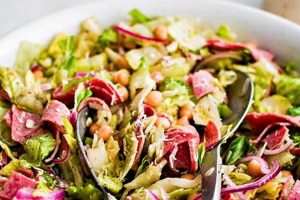Salads encompass a vast culinary landscape, extending far beyond the basic lettuce-and-tomato combination. They can incorporate diverse ingredients, including various leafy greens, vegetables, fruits, nuts, cheeses, proteins, and grains, combined with a wide array of dressings. Examples range from simple green salads with vinaigrette to complex composed salads featuring grilled meats or seafood.
The versatility of salads offers numerous nutritional and culinary advantages. They provide opportunities to consume a variety of fresh produce, contributing essential vitamins, minerals, and fiber to the diet. Salads can be tailored to individual dietary needs and preferences, serving as light lunches, appetizers, or side dishes to complement heartier meals. Historically, salads have played a role in diverse cuisines, evolving from simple preparations to elaborate culinary creations reflecting cultural influences and seasonal ingredients.
This article will explore various salad categories, offering insights into their composition, nutritional value, and preparation techniques. From refreshing summer salads to hearty winter options, readers will discover a world of culinary possibilities within the realm of salad creation.
Tips for Creating Diverse and Delicious Salads
Crafting compelling salads involves thoughtful consideration of ingredients, textures, and flavors. These tips offer guidance for elevating salad preparation beyond the ordinary.
Tip 1: Explore a Variety of Greens: Move beyond iceberg lettuce. Consider spinach, kale, arugula, romaine, or butter lettuce for diverse flavors and textures. Mixing greens adds complexity.
Tip 2: Balance Flavors and Textures: Combine contrasting elements. Pair crunchy vegetables with softer ones, and balance sweet and savory ingredients. Consider adding nuts, seeds, or croutons for textural contrast.
Tip 3: Dressings Make a Difference: Experiment with different dressings. Vinaigrettes, creamy dressings, or even a simple drizzle of olive oil and lemon juice can enhance flavor profiles. Match the dressing to the salad’s ingredients.
Tip 4: Season Properly: Don’t just salt and pepper at the end. Seasoning throughout the preparation process, from the vegetables to the dressing, builds layers of flavor.
Tip 5: Add Protein for Substance: Incorporate grilled chicken, fish, beans, lentils, or tofu to create more substantial salads that can serve as a complete meal.
Tip 6: Don’t Forget the Herbs: Fresh herbs can dramatically elevate a salad’s flavor. Parsley, cilantro, mint, basil, and chives add brightness and complexity.
Tip 7: Consider Seasonal Ingredients: Utilize fresh, seasonal produce for optimal flavor and nutritional value. Farmers’ markets offer inspiration and access to a wide variety of seasonal offerings.
By employing these tips, one can transform simple salads into culinary masterpieces that are both nutritious and satisfying. These guidelines offer a foundation for exploring the endless possibilities within the realm of salad creation.
This exploration of salad variety concludes with a focus on adapting these principles to individual preferences and dietary needs, emphasizing the versatility and adaptability of salads within a balanced diet.
1. Green Salads
Green salads represent a foundational category within the broader spectrum of salad recipes. Characterized by a base of leafy greens, these salads offer a versatile platform for incorporating a wide array of other ingredients. This foundational role stems from the neutral flavor profile of many greens, allowing them to complement diverse flavors and textures without overpowering the overall composition. The simplicity of a green salad also provides a canvas for culinary creativity, enabling chefs and home cooks alike to experiment with various combinations of vegetables, fruits, proteins, and dressings. For instance, a simple spinach salad can be transformed with the addition of strawberries, goat cheese, and candied pecans, demonstrating the adaptability of this basic salad type.
The importance of green salads within the broader context of salad recipes lies in their nutritional value and culinary versatility. Leafy greens offer essential vitamins and minerals, contributing to a healthy diet. Their refreshing nature makes them ideal for warm weather, while their adaptability allows for year-round enjoyment with seasonal ingredient additions. Furthermore, green salads can function as a light meal, a side dish, or an appetizer, demonstrating their flexibility within various culinary contexts. From a simple tossed green salad with vinaigrette to more complex compositions incorporating roasted vegetables or grilled protein, the possibilities are extensive.
Understanding the role of green salads as a cornerstone of salad preparation allows for a greater appreciation of their culinary potential. While seemingly basic, these salads provide a foundation for countless variations, demonstrating the inherent versatility within this category. This understanding empowers individuals to create balanced, flavorful, and nutritious meals centered around the simple elegance of leafy greens. The adaptability of green salads to diverse dietary needs and culinary preferences solidifies their position as a staple within the diverse world of salad recipes.
2. Vegetable Salads
Vegetable salads represent a significant category within the diverse landscape of salad recipes. Their prominence stems from the inherent versatility of vegetables, offering a wide range of flavors, textures, and colors to create both simple and complex salad compositions. This versatility allows for the creation of salads tailored to specific dietary needs, seasonal availability, and culinary preferences. The causal relationship between vegetable availability and salad composition is evident; the abundance of fresh produce directly influences the variety and creativity possible within vegetable salad preparations. For example, a summer vegetable salad might feature ripe tomatoes, cucumbers, and bell peppers, while a winter version might incorporate roasted root vegetables like carrots, beets, and sweet potatoes. This adaptability highlights the importance of vegetable salads as a component of diverse salad recipes.
The practical significance of understanding the role of vegetables in salads lies in the ability to create nutritionally balanced and flavorful meals. Combining different vegetables provides a broader spectrum of vitamins, minerals, and dietary fiber. Furthermore, the interplay of textures and flavors within a vegetable salad enhances the overall sensory experience. Consider a salad combining crunchy carrots, juicy tomatoes, and crisp cucumbersthe contrasting textures create a more engaging and satisfying meal. Beyond individual ingredients, the choice of dressing also significantly impacts the overall flavor profile. A light vinaigrette complements the fresh flavors of raw vegetables, while a creamy dressing might enhance the richness of roasted or grilled vegetables. Understanding these nuances enables the creation of well-balanced and flavorful vegetable salads appropriate for various occasions and palates.
In summary, vegetable salads play a crucial role within the broader context of salad recipes. Their adaptability to seasonal ingredients, dietary requirements, and culinary preferences makes them a versatile and valuable component of a balanced diet. Understanding the interplay of flavors, textures, and dressings allows for the creation of vegetable salads that are both nutritious and enjoyable, solidifying their position as a cornerstone of diverse culinary traditions. This understanding empowers individuals to explore the vast potential of vegetables within the realm of salad creation, promoting culinary creativity and healthy eating habits.
3. Fruit Salads
Fruit salads occupy a distinct niche within the diverse realm of salad recipes. Characterized by the prominent use of fresh or preserved fruits, these salads offer a refreshing and often sweet counterpoint to other salad categories. Their unique composition contributes to their versatility, allowing them to function as appetizers, desserts, or light snacks. Understanding the role of fruit salads within the broader context of salad recipes necessitates an exploration of their diverse components, preparation methods, and culinary applications.
- Composition and Variety
Fruit salads showcase the wide array of available fruits, from common options like berries and melons to more exotic choices like mangoes and papayas. The selection of fruits influences the salad’s overall flavor profile, ranging from tart and tangy to sweet and mellow. Incorporating a variety of textures, such as the softness of berries alongside the crispness of apples, adds complexity and enhances the sensory experience. Consider a fruit salad combining blueberries, strawberries, kiwi, and grapesthe interplay of sweet and tart flavors, along with varied textures, creates a dynamic and enjoyable culinary experience. This compositional diversity underscores the versatility of fruit salads within the broader context of salad recipes.
- Preparation and Techniques
Preparation methods for fruit salads vary depending on the chosen ingredients and desired outcome. Some fruits require minimal preparation, such as washing and slicing, while others may benefit from peeling, coring, or dicing. Macerating fruits in juices or syrups can enhance their sweetness and infuse additional flavors. For example, marinating berries in a balsamic glaze adds a depth of flavor that complements their natural sweetness. These techniques demonstrate the nuanced approach to fruit salad preparation and its impact on the final product’s flavor and texture.
- Culinary Applications and Versatility
Fruit salads exhibit versatility in their culinary applications. They can serve as refreshing appetizers, light desserts, or standalone snacks. Their adaptability extends to pairings with other dishes, such as grilled meats or yogurt parfaits. A fruit salad featuring grilled pineapple and mango complements savory dishes, while a berry-based salad with a dollop of whipped cream provides a satisfying dessert. This versatility distinguishes fruit salads within the wider range of salad recipes, offering unique culinary possibilities.
- Nutritional Value and Health Benefits
Fruit salads contribute to a balanced diet by providing essential vitamins, minerals, and dietary fiber. The inherent nutritional value of fruits translates directly to the health benefits of consuming fruit salads. The variety of fruits within a salad further enhances the nutritional profile, offering a wider spectrum of nutrients. For instance, a fruit salad incorporating citrus fruits, berries, and melons provides vitamin C, antioxidants, and hydration, highlighting the nutritional contribution of fruit salads within the context of healthy eating and diverse salad recipes.
In conclusion, fruit salads offer a unique and refreshing perspective within the spectrum of salad recipes. Their versatility in composition, preparation, and culinary application distinguishes them as a valuable addition to diverse dietary preferences and culinary traditions. By understanding the unique aspects of fruit salads, one can appreciate their role within the broader context of salad preparation and their contribution to balanced and enjoyable meals.
4. Protein Salads
Protein salads represent a substantial category within the diverse landscape of salad recipes. Their significance derives from the incorporation of protein-rich ingredients, transforming salads from side dishes into complete, satisfying meals. This functional shift expands the culinary role of salads, offering a more nutritionally balanced approach to meal preparation. The inclusion of protein directly influences satiety, making these salads a valuable option for those seeking a filling yet healthy meal. The relationship between protein content and salad type is crucial; the choice of protein dictates the overall flavor profile and complements other ingredients. For example, grilled chicken pairs well with lighter dressings and fresh vegetables, while seared tuna complements bolder flavors and Asian-inspired ingredients. This interplay highlights the importance of protein selection within the broader context of different types of salad recipes.
The practical implications of understanding the role of protein in salads lie in the ability to create customized meals tailored to individual dietary needs and preferences. Incorporating plant-based proteins like lentils, beans, or tofu caters to vegetarian and vegan diets, while animal-based proteins like chicken, fish, or eggs offer alternative options. Furthermore, the choice of protein influences the salad’s nutritional value, contributing essential amino acids and supporting muscle growth and repair. Consider a salad featuring grilled salmon, quinoa, and roasted vegetablesthe combination offers a complete protein source, complex carbohydrates, and essential vitamins and minerals. This example demonstrates the practical application of combining protein with complementary ingredients to create a balanced and nutritious meal within the context of different types of salad recipes.
In summary, protein salads hold a key position within the diverse world of salad recipes. Their ability to transform salads into substantial meals expands their culinary versatility and nutritional value. Understanding the relationship between protein selection, complementary ingredients, and overall flavor profiles allows for the creation of customized salads tailored to individual needs and preferences. This understanding empowers individuals to leverage the versatility of protein salads, contributing to a more balanced and satisfying approach to healthy eating within the broader context of different types of salad recipes.
5. Pasta Salads
Pasta salads occupy a unique position within the diverse spectrum of salad recipes. Their defining characteristic, the incorporation of cooked pasta as a base, distinguishes them from leafy green or vegetable-centric salads. This foundational element contributes to their versatility, allowing pasta salads to function as standalone meals, side dishes, or components of potlucks and picnics. The relationship between pasta type and salad composition is significant; the choice of pasta shape and size influences the overall texture and ability to absorb dressings and flavors. For example, rotini or farfalle hold dressings well, while penne or orzo offer a different textural experience. This interplay between pasta and other ingredients highlights the importance of pasta selection within the broader context of different types of salad recipes. The versatility of pasta salads stems from their adaptability to various ingredients and flavor profiles. They can incorporate vegetables, proteins, cheeses, herbs, and a wide range of dressings, creating a balanced and flavorful meal. A classic pasta salad might include cooked pasta, chopped vegetables like bell peppers and cucumbers, cubed cheese, and a vinaigrette dressing. Adding grilled chicken or chickpeas elevates the nutritional value and transforms the salad into a more substantial meal. These examples demonstrate the adaptability of pasta salads and their ability to cater to diverse dietary needs and preferences.
The practical significance of understanding pasta salads within the broader context of different types of salad recipes lies in the ability to create versatile and satisfying meals. Choosing the appropriate pasta shape, incorporating complementary ingredients, and selecting a flavorful dressing are key considerations. Furthermore, pasta salads can be prepared in advance, making them a convenient option for gatherings or busy weeknight meals. Understanding the principles of flavor balance and ingredient compatibility allows for the creation of customized pasta salads that are both nutritious and enjoyable. For instance, a Mediterranean-inspired pasta salad might incorporate orzo pasta, feta cheese, olives, artichoke hearts, and a lemon-herb vinaigrette, offering a refreshing and flavorful meal. Such examples showcase the practical application of combining pasta with complementary ingredients and dressings to create diverse and satisfying salad options.
In summary, pasta salads contribute significantly to the variety inherent in different types of salad recipes. Their unique composition, versatility in ingredient incorporation, and adaptability to diverse culinary contexts distinguish them as valuable components of balanced meals and social gatherings. Understanding the nuances of pasta selection, ingredient compatibility, and flavor balance empowers individuals to create customized pasta salads that are both nutritious and enjoyable, further solidifying their position within the diverse world of salad recipes.
6. Composed Salads
Composed salads represent a sophisticated category within the diverse landscape of salad recipes. Unlike tossed salads where ingredients are mixed together, composed salads feature artfully arranged components, creating visually appealing and texturally complex dishes. This deliberate arrangement elevates the salad from a simple mixture to a carefully constructed culinary creation. Understanding the principles of composed salads provides valuable insights into the broader spectrum of salad recipes and expands culinary creativity.
- Structure and Design
Composed salads emphasize intentional design. Ingredients are not merely combined but strategically placed to create visual appeal and balanced flavor distribution. A typical structure involves a base of greens, followed by layers of vegetables, proteins, cheeses, and other complementary elements. For example, a Nicoise salad features a bed of lettuce topped with arranged rows of tomatoes, hard-boiled eggs, olives, anchovies, and tuna. This structured approach distinguishes composed salads within the broader context of different types of salad recipes and emphasizes the importance of visual presentation in culinary arts.
- Ingredient Selection and Compatibility
Ingredient selection in composed salads requires careful consideration of flavor and texture compatibility. Each element contributes to the overall balance and complexity of the dish. Contrasting textures, such as crunchy vegetables alongside creamy cheeses, create a more engaging sensory experience. Flavor pairings, like sweet and savory or tart and tangy, add depth and dimension. A classic Cobb salad exemplifies this principle, combining crisp lettuce, grilled chicken, bacon, avocado, tomatoes, blue cheese, and a vinaigrette dressing. The interplay of flavors and textures creates a harmonious and satisfying whole, demonstrating the importance of ingredient compatibility within composed salads and the broader context of different types of salad recipes.
- Dressings and Sauces
Dressings in composed salads often play a more nuanced role than in tossed salads. Instead of coating all ingredients uniformly, dressings can be drizzled, dolloped, or served on the side, allowing diners to control the intensity of flavor. The choice of dressing should complement the chosen ingredients and enhance the overall balance of the salad. A light vinaigrette might accompany a delicate seafood salad, while a creamy dressing could enhance a salad featuring roasted vegetables and grilled meats. This nuanced approach to dressing application distinguishes composed salads from other salad types and emphasizes the importance of flavor balance within the broader context of different types of salad recipes.
- Culinary Applications and Versatility
Composed salads demonstrate versatility in their culinary applications. They can serve as elegant appetizers, light lunches, or satisfying main courses. Their adaptability extends to various cuisines and culinary traditions, reflecting diverse cultural influences. A composed salad featuring grilled halloumi, roasted vegetables, and a lemon-herb dressing represents Mediterranean cuisine, while a salad incorporating seared tuna, avocado, and a sesame-ginger dressing reflects Asian-inspired flavors. This culinary versatility highlights the adaptability of composed salads within the broader context of different types of salad recipes and showcases their ability to cater to a range of culinary preferences and occasions.
In conclusion, composed salads hold a distinct position within the diverse realm of salad recipes. Their emphasis on structure, ingredient compatibility, nuanced dressing application, and culinary versatility sets them apart from other salad types. Understanding the principles of composed salad creation enhances culinary creativity and allows for a greater appreciation of the artistry involved in crafting visually appealing and flavorfully balanced dishes. This understanding broadens the perspective on different types of salad recipes and empowers individuals to explore the vast potential of salads as a culinary medium.
Frequently Asked Questions
This section addresses common inquiries regarding the diverse world of salad preparation, offering practical guidance and clarifying potential misconceptions.
Question 1: How can one create salads that are both nutritious and flavorful?
Nutritional value and flavor can coexist harmoniously in salads. Select a variety of colorful vegetables, incorporate lean proteins, and choose healthy fats like nuts, seeds, or avocado. Experiment with herbs, spices, and homemade dressings to enhance flavor without relying on excessive salt or sugar.
Question 2: What are some strategies for preventing salads from becoming soggy?
Soggy salads can be avoided through proper preparation and storage techniques. Thoroughly dry greens after washing. Store dressings separately and add them just before serving. If adding ingredients with high water content, such as tomatoes or cucumbers, consider placing them on top of the greens or in a separate container.
Question 3: Are salads suitable for meal prepping?
Salads can be successfully incorporated into meal preparation strategies. Store components separately, combining them just before consumption. Pack dressings in individual containers to prevent premature wilting. Heartier greens like kale or romaine hold up better than more delicate greens like spinach or butter lettuce.
Question 4: How can individuals adapt salad recipes to accommodate dietary restrictions?
Adaptability is a key advantage of salads. Dietary restrictions can be accommodated through ingredient substitutions. Replace animal-based proteins with plant-based alternatives like beans, lentils, or tofu. Use gluten-free pasta or quinoa for gluten-free options. Dairy-free dressings can be easily prepared with olive oil, vinegar, and herbs.
Question 5: What are some creative ways to incorporate seasonal ingredients into salads?
Seasonal produce elevates salad flavors and nutritional value. Explore farmers’ markets for inspiration and access to fresh, locally sourced ingredients. Incorporate seasonal fruits like berries in summer or roasted root vegetables in winter. Adjust dressings and other components to complement the seasonal flavors.
Question 6: Beyond leafy greens, what other bases can be used for salads?
Grains like quinoa, farro, or barley provide nutritious and flavorful alternatives to leafy greens. Pasta, couscous, and rice noodles offer additional options. These bases create heartier salads that can serve as complete meals.
By understanding these fundamental principles, individuals can approach salad preparation with greater confidence and creativity, maximizing both flavor and nutritional value. This knowledge empowers informed choices regarding ingredient selection, preparation techniques, and dietary adaptations.
The following section provides a collection of diverse salad recipes, offering practical examples of these principles in action.
Culinary Versatility and Nutritional Benefits of Different Types of Salad Recipes
This exploration of different types of salad recipes has highlighted their remarkable versatility and nutritional significance. From the foundational simplicity of green salads to the artful complexity of composed salads, each category offers unique culinary possibilities. The adaptability of salads to incorporate diverse ingredients, accommodate dietary restrictions, and reflect seasonal variations underscores their value within a balanced and health-conscious diet. The analysis of various salad components, including bases, proteins, vegetables, fruits, and dressings, provides a comprehensive framework for understanding their individual contributions to flavor, texture, and nutritional value. The practical considerations discussed, such as preventing sogginess and adapting recipes for meal prepping, empower informed decision-making in salad preparation.
The diversity inherent in different types of salad recipes presents an opportunity to embrace culinary creativity and explore a world of flavors. Continued exploration of ingredient combinations, dressing variations, and presentation styles can further elevate the culinary experience and promote the integration of fresh, wholesome ingredients into everyday meals. Ultimately, an understanding of the diverse landscape of salad recipes empowers individuals to make informed choices that support both culinary satisfaction and nutritional well-being.






